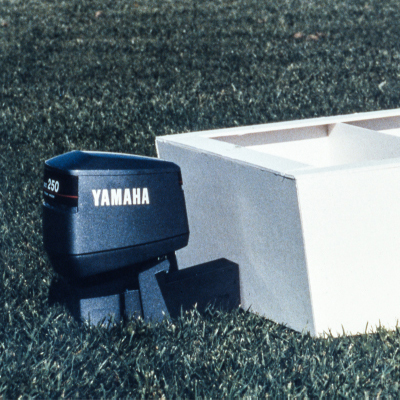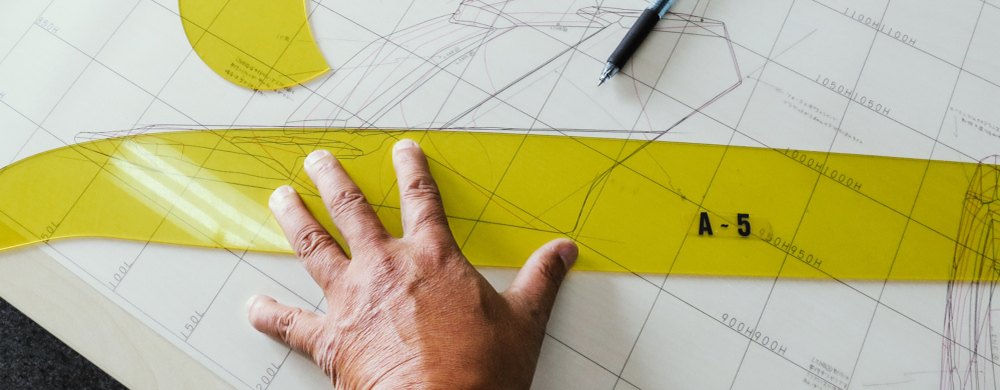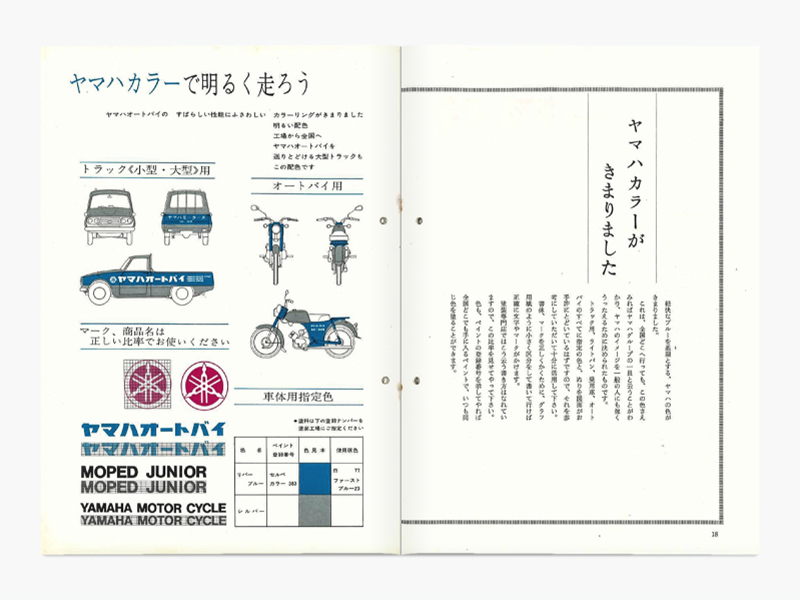DAYSIN THE STUDIO
Human beings have an instinctive ability to use their ingenuity to piece together things close at hand in order to make something they need; the French call it bricolage.
To turn visions of the imagination into something real, designers draw sketches and craft three-dimensional models.
They must also get the engineering team to understand the intentions behind a design, and have come up with all number of methods to accomplish this.

Presentation on the Water
In a presentation room at Yamaha Motor headquarters, countless products have been reviewed and discussed over the years. It is a process repeated as the natural course of events, but it’s not as if there were never people who had doubts about its validity. For example, with outboard motors, some said that since it was a product used on the water, the graphics designed for them should be reviewed out on the water. That led to the actual holding of a presentation on the water at Lake Hamana. The outboard with the new graphics was mounted on a boat and the evaluation team got in another boat and circled around it. As the outboard rocked with the boat on the water, they could see how the colors and the light of the water and the sky reflected off it.
For the presentation to a Yamaha Motor group company in the U.S., a lawn was used to resemble the surface of the water and a 1/3-scale clay outboard model painted in the new graphics was mounted on a 1/3-scale model boat. The Yamaha designers insisted that the design should be reviewed from the users’ eye level and angle of sight, but the argument of the YMUS sales representatives had a point: “No, customers here are looking up at the outboard when they’re on display at a dealership.”

The Fruits of Labor
from the Hand-Drafting Era
Before there were color photocopiers or projectors, the rendering of a design required about a week to finish. The designers would take their 1/4-scale sketches to a copying service in town. There, an enlarged copy came in two sections (upper and lower) and was carefully taped together before backing it with semi-transparent paper that came in 50 millimeter sections. Next a full-scale tape drawing would be made and carefully masked, after which an air-brush was used to paint in the color. Every detail from the tire pattern to the individual screws had to be drawn by hand. To do all of this labor-intensive work as efficiently as possible, there were four drawing tables with raising and lowering mechanisms in the rendering room in the old Design Building.
Also, in the days when all diagrams were drawn by hand, whenever a clay model was finished, the designers had
to rely on low-precision, hand-plotted data points to create mechanical drawings on non-stretching Mylar paper with a drafting ruler and ballpoint pen. The front-, top- and side-view diagrams had to be checked over and over again with numerous paper rulers to make sure they were aligned—it could make you feel like fainting. When those mechanical drawings were finally finished, the engineers would add in the structural elements, then pass it on to a craftsperson to make a wooden master mold, from which the gypsum casting method was then used to make a metal mold carved out with profile machining. After that, when we entered the era when we could translate the diagrams into electronic data, the basic thought process still remained based in hand-drawn diagraming.

Building and
Developing
“One Yamaha”
The logos and colors that represent and symbolize a brand are only truly effective if they are used in a unified and regulated way. Of course, one of the tasks of design is to play a leading role in this area. However, back when such understandings were still rare and the organization and tools for this task were lacking, there were different Yamaha brand images and characters being built up within the various markets, and even within our various lines of business.
For example, it was noted in the mid-1980s that different Yamaha logos were being used on our outboard motors in Europe and in North America, so this isn’t exactly ancient history. It was the designers who saw this as a problem and took action to unify logo and color use globally. Also, in designating a globally unified color for Yamaha outboard motors in 1998 (later changed to Grayish Purple Gray Metallic), it was designers who played a vital role.
Issue No. 18 of the Yamaha News newsletter for dealerships published in 1964 explained the aims behind proper use of Yamaha logos and colors to motorcycle dealers. It included simple directions for drawing logos with correct proportions on graph paper and instructions for placing orders with local paint shops. This was one of the first steps in our efforts to create a single brand, “One Yamaha” extending to every corner of the market.





